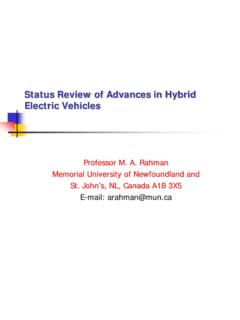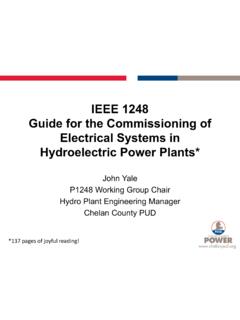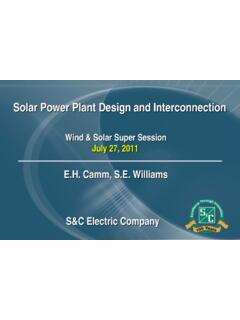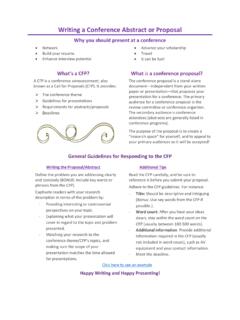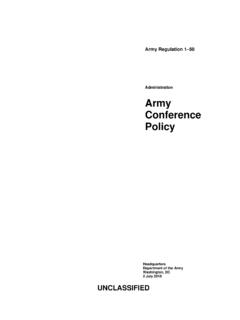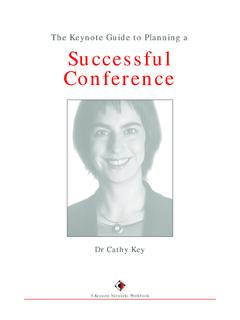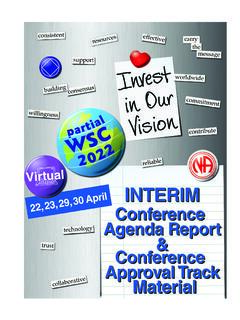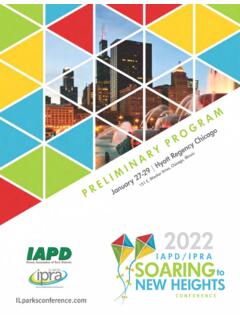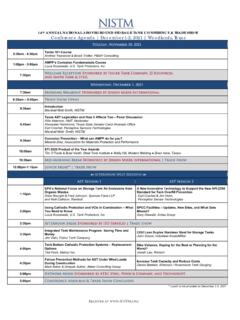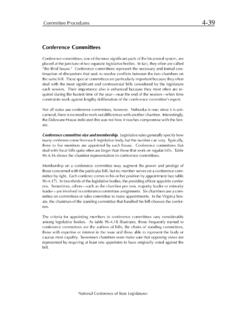Transcription of Preparation of a Formatted Conference Paper for an IEEE ...
1 Preparation of a Formatted Conference Paper for an IEEE Power & Energy Society Conference Line 1: Authors Name/s per 1st Affiliation Line 2: Author s Name/s per 1st Affiliation Line 3 (of Affiliation): Dept. name of organization Line 4: name of organization, acronyms acceptable Line 5: City, Country Line 6: e-mail address if desired Line 1: Authors Name/s per 2nd Affiliation Line 2: Author s Name/s per 1st Affiliation Line 3 (of Affiliation): Dept. name of organization Line 4: name of organization, acronyms acceptable Line 5: City, Country Line 6: e-mail address if desired Abstract Basic guidelines for the Preparation of a technical Paper for an IEEE Power & Energy Society Conference are presented. This electronic document is a live template. The various components of your Paper [title, text, headings, etc.] are already defined, as illustrated by the portions given in this document.
2 The abstract is limited to 150 words and cannot contain equations, figures, tables, or references. It should concisely state what was done, how it was done, principal results, and their significance. Index Terms--The author shall provide up to 5 keywords (in alphabetical order) to help identify the major topics of the Paper . The thesaurus of IEEE indexing keywords is posted at I. INTRODUCTION (HEADING 1) This template provides authors with most of the formatting specifications needed for preparing electronic versions of PES Conference papers. All standard Paper components have been specified for three reasons: (1) ease of use when formatting individual papers, (2) automatic compliance to electronic requirements that facilitate the concurrent or later production of electronic products, and (3) conformity of style throughout a Conference s proceedings.
3 Margins, column widths, line spacing, and type styles are built-in; examples of the type styles are provided throughout this document and are identified in italic type, within parentheses, following the example. Some components, such as multi-leveled equations, graphics, and tables are not prescribed, although the various table text styles are provided. The formatter will need to create these components, incorporating the applicable criteria that follow. II. EASE OF USE A. Template (Heading 2) This template has been tailored for output on US letter-sized Paper . B. Maintaining the Integrity of the Specifications The template is used to format your Paper and style the text. All margins, column widths, line spaces, and text fonts are prescribed; please do not alter them. You may note peculiarities. For example, the heading margin in this template measures proportionately more than is customary.
4 This measurement and others are deliberate, using specifications that anticipate your Paper as one part of the entire proceedings, and not as an independent document. Please do not revise any of the current designations. III. Conference Paper Preparation Conference papers are limited to a maximum of five pages. Please use automatic hyphenation and check your spelling. Additionally, be sure your sentences are complete and that there is continuity within your paragraphs. Check the numbering of your graphics (figures and tables) and make sure that all appropriate references are included. Please take note of the following items when proofreading spelling and grammar: A. Abbreviations and Acronyms Define abbreviations and acronyms the first time they are used in the text, even after they have been defined in the abstract. Abbreviations such as IEEE, SI, ac, dc, and rms do not have to be defined.
5 Do not use abbreviations in the title or section headings unless they are unavoidable. B. Units Metric units are preferred for use in IEEE publications in light of their global readership and the inherent convenience of these units in many fields. In particular, the use of the International System of Units (Systeme Internationale d'Unites or SI Units) is advocated. This system includes a subsystem of units based on the meter, kilogram, second, and ampere (MKSA). Customary units, or British units, may be used as secondary units (in parentheses). An Identify applicable sponsor/s here. (sponsors)exception is when Customary units are used as identifiers in trade, such as disk drive. Avoid combining SI and Customary units, such as current in amperes and magnetic field in oersteds. This often leads to confusion because equations do not balance dimensionally.
6 If you must use mixed units, clearly state the units for each quantity that you use in an equation. Do not mix complete spellings and abbreviations of units: Wb/m2 or webers per square meter , not webers/m2 . Spell out units when they appear in text: .. a few henries , not .. a few H . Use a zero before decimal points: , not .25 . Use cm3 , not cc . (bullet list) C. Equations The equations are an exception to the prescribed specifications of this template. You will need to determine whether or not your equation should be typed using either the Times New Roman or the Symbol font (please no other font). To create multileveled equations, it may be necessary to treat the equation as a graphic and insert it into the text after your Paper is styled. Use of the Microsoft Equation Editor or the MathType commercial add-on for MS Word for math objects in your Paper is permissible (Insert | Equation or MathType Equation).
7 "Float over text" should not be selected. Number equations consecutively. Equation numbers, within parentheses, are to position flush right, as in (1), using a right tab stop. To make your equations more compact, you may use the solidus ( / ), the exp function, or appropriate exponents. Italicize Roman symbols for quantities and variables, but not Greek symbols. Use a long dash, as shown in (1), rather than a hyphen for a minus sign. Punctuate equations with commas or periods when they are part of a sentence, as in Note that the equation above is centered using a center tab stop. Be sure that the symbols in your equation have been defined before or immediately following the equation. Use (1) , not Eq. (1) or equation (1) , except at the beginning of a sentence: Equation (1) is .. D. Footnotes Number footnotes separately in superscripts.
8 Place the actual footnote at the bottom of the column in which it was cited. Do not put footnotes in the reference list. Use letters for table footnotes. E. Some Common Mistakes The word data is plural, not singular. The subscript for the permeability of vacuum 0, and other common scientific constants, is zero with subscript formatting, not a lowercase letter o . In American English, commas, semi-/colons, periods, question and exclamation marks are located within quotation marks only when a complete thought or name is cited, such as a title or full quotation. When quotation marks are used, instead of a bold or italic typeface, to highlight a word or phrase, punctuation should appear outside of the quotation marks. A parenthetical phrase or statement at the end of a sentence is punctuated outside of the closing parenthesis (like this).
9 (A parenthetical sentence is punctuated within the parentheses.) A graph within a graph is an inset , not an insert . The word alternatively is preferred to the word alternately (unless you really mean something that alternates). Do not use the word essentially to mean approximately or effectively . In your Paper title, if the words that uses can accurately replace the word using , capitalize the u ; if not, keep using lower-cased. Be aware of the different meanings of the homophones affect and effect , complement and compliment , discreet and discrete , principal and principle . Do not confuse imply and infer . The prefix non is not a word; it should be joined to the word it modifies, usually without a hyphen. There is no period after the et in the Latin abbreviation et al.. The abbreviation means that is , and the abbreviation means for example.
10 IV. USING THE TEMPLATE This document should be used as a template for preparing your Conference Paper . You may type over sections of the document, cut and paste into it, and/or use markup styles. Duplicate the template file by using the Save As command, and use the naming convention prescribed by your Conference for the name of your Paper . A. Authors and Affiliations The template is designed so that author affiliations are not repeated each time for multiple authors of the same affiliation. Please keep your affiliations as succinct as possible (for example, do not differentiate among departments of the same organization). This template was designed for two affiliations. 1) For author/s of only one affiliation (Heading 3): To change the default, adjust the template as follows. a) Selection (Heading 4): Highlight all author and affiliation lines. b) Change number of columns: Select the Columns icon from the MS Word Standard toolbar and then select 1 Column from the selection palette.

